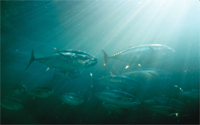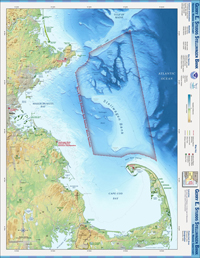Draft Management Plan for NOAA’s Stellwagen Bank National Marine Sanctuary Released for Public Review and Comment
May 6, 2008
NOAA today released a comprehensive draft management plan and environmental assessment for Stellwagen Bank National Marine Sanctuary for public review and comment. Based on several years of scientific study and extensive public input, the plan recommends specific actions to address issues impacting the sanctuary.
“The draft management plan is the result of a collaborative effort that includes thousands of people and the hard work of sanctuary staff and the sanctuary’s advisory council,” said Daniel J. Basta, director of the NOAA Office of National Marine Sanctuaries. “We welcome further public review and comment as we go forward with the important job of managing this special undersea place for future generations to enjoy.”
The new draft plan, a major revision to the sanctuary’s original management plan published in 1993, focuses on key issues affecting the sanctuary, including ecosystem alteration, wildlife disturbance, vessel traffic and its potential threat to marine mammals, water quality and invasive species.
The plan also addresses important sanctuary programs such as maritime heritage preservation, conservation science, enforcement, interagency cooperation, public outreach and education, and infrastructure development. No changes to sanctuary regulations are proposed in this draft plan.

Atlantic bluefin tuna (Thunnus thynnus) cruise through the sanctuary during their annual migrations up the eastern seaboard.
High Resolution (Credit: NOAA)
“This plan is centered on the need to manage marine resources for biodiversity conservation,” said sanctuary superintendent Craig MacDonald. “This is an evolving approach that stresses the management of the entire sanctuary ecosystem, including all biological communities, habitats and species populations, together with compatible human uses.”
Periodic management plan review is required by Congress for each of the 13 national marine sanctuaries to ensure that they continue to conserve, protect and enhance their nationally significant living and cultural resources while allowing compatible commercial and recreational activities.
All comments must be received by Aug. 4, 2008. Written comments should be sent by mail to: Dr. Craig MacDonald, sanctuary superintendent, Stellwagen Bank National Marine Sanctuary, 175 Edward Foster Road, Scituate, MA 02066; by e-mail to sbplan@noaa.gov; or by fax to 781-545-8036.
Public meetings will be held at the following locations:
- June 5 – Portland, ME: University of Southern Maine School of Law, Talbot Lecture Hall, 88 Bedford Street; 6:30 p.m.
- June 9 – Wenham, MA: Gordon College, Lane Student Center, President’s Dining Room, 255 Grapevine Road; 6:30 p.m.
- June 10 – Boston, MA: Boston University, School of Management, Rooms 426 & 428, 595 Commonwealth Avenue; 6:30 p.m.
- June 11 – Plymouth, MA: Hilton Garden Inn Plymouth, Plymouth Rooms 1 & 2, Four Home Depot Drive; 6:30 p.m.
- June 12 – Hyannis, MA: Cape Codder Resort, JFK Ballroom, 1225 Iyanough Road, Route 132 & Bearse’s Way; 6:30 p.m.
- June 16 – Portsmouth, NH: Sheraton Portsmouth Harborside Hotel, Harbor’s Edge Room, 250 Market Street; 6:30 p.m.
- June 17 – N. Dartmouth, MA: University of Massachusetts, Dartmouth, Woodland Common, 285 Old Westport Road; 6:30 p.m.
- June 19 – Mystic, CT: Mystic Aquarium, Maine Exhibit Hall, 55 Coogan Boulevard; 6:30 p.m.
Copies of the draft management plan and environmental assessment on CD are available at Stellwagen Bank National Marine Sanctuary’s headquarters offices in Scituate. CDs may be requested by calling 781-545-8026 or via e-mail at sbplan@noaa.gov. The plan may also be downloaded from the sanctuary’s Web site.
Printed copies of the draft management plan and environmental assessment are being sent to libraries and other public facilities in the New England region. A listing of locations where the printed document can be reviewed is available on the sanctuary’s Web site.
Stellwagen Bank National Marine Sanctuary encompasses 842 square miles of ocean, stretching between Cape Ann and Cape Cod offshore of Massachusetts. Renowned for its scenic beauty and remarkable productivity, the sanctuary supports a rich variety of marine life, including marine mammals, seabirds, fishes and marine invertebrates. The sanctuary’s location near historic shipping routes and fishing grounds for Massachusetts’ oldest ports also makes it a resting place for shipwrecks representing several hundred years of maritime transportation.
The National Oceanic and Atmospheric Administration, an agency of the U.S. Commerce Department, is dedicated to enhancing economic security and national safety through the prediction and research of weather and climate-related events and information service delivery for transportation, and by providing environmental stewardship of our nation's coastal and marine resources. Through the emerging Global Earth Observation System of Systems (GEOSS), NOAA is working with its federal partners, more than 70 countries and the European Commission to develop a global monitoring network that is as integrated as the planet it observes, predicts and protects.

